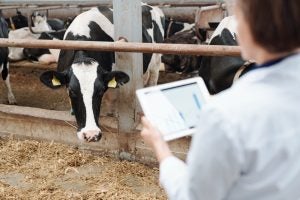Today, the USDA’s Animal and Plant Health Inspection Service unveiled a Federal Order introducing measures to protect the livestock industry against highly pathogenic H5N1 avian influenza.
The Federal Order may be viewed here and is effective on Monday, April 29, 2024. Its highlights include:
Mandatory testing for interstate movement of dairy cattle
- Prior to interstate movement, dairy cattle are required to receive a negative test for Influenza A virus at an approved National Animal Health Laboratory Network laboratory
- Owners of herds in which dairy cattle test positive for interstate movement will be required to provide epidemiological information, including animal movement tracing
- Dairy cattle moving interstate must adhere to conditions specified by APHIS
- As will be described in forthcoming guidance, these steps will be immediately required for lactating dairy cattle, while these requirements for other classes of dairy cattle will be based on scientific factors concerning the virus and its evolving risk profile
Mandatory Reporting
- Laboratories and state veterinarians must report positive Influenza A nucleic acid detection diagnostic results (PCR or genetic sequencing) in livestock to USDA APHIS
- Laboratories and state veterinarians must report positive Influenza A serology diagnostic results in livestock to USDA APHIS
The USDA has identified spread between cows within the same herd, spread from cows to poultry, spread between dairies associated with cattle movements, and cows without clinical signs that have tested positive.
On April 16, APHIS microbiologists identified a shift in an H5N1 sample from a cow in Kansas that could indicate that the virus has an adaptation to mammals.

The Centers for Disease Control and Prevention conducted further analysis of the specimen sequence, which did not change their overall risk assessment for the general public because the substitution has been seen previously in other mammalian infections and does not impact viral transmission. Additionally, APHIS’ National Veterinary Services Laboratories found H5N1 in a lung tissue sample from an asymptomatic cull dairy cow that originated from an affected herd and did not enter the food supply.
The novel movement of H5N1 between wild birds and dairy cows requires further testing and time to develop a critical understanding to support any future courses of action.
“While we are taking this action today, it is important to remember that thus far, we have not found changes to the virus that would make it more transmissible to humans and between people,” writes the USDA. “While cases among humans in direct contact with infected animals are possible, our partners at the U.S. Centers for Disease Control and Prevention believe that the current risk to the public remains low.”
To maximize understanding and research on H5N1 in dairy cattle, on April 21, APHIS made publicly available 239 genetic sequences from the U.S. H5N1 clade 2.3.4.4b influenza virus recently found in samples associated with the ongoing HPAI outbreak in poultry and wild birds, and the recent H5N1 event in dairy cattle.
APHIS has also offered virus samples to interested researchers to facilitate epidemiological study.
“Increasing our understanding of this disease and how it spreads is critical to stopping it,” writes the USDA. “This is why APHIS is urging dairy cattle producers and those who work in or with the industry to share epidemiological information from affected farms, even if they are not planning to move cattle interstate.”
APHIS further urges producer participation in public health assessments to continue to confirm worker safety and monitor for any potential changes in the virus that could impact transmissibility.
Milk safety recommendations include pasteurization
In addition, partners in the U.S. Food and Drug Administration released an update on the ongoing work to ensure the continued effectiveness of the federal-state milk safety system. It is important to emphasize that, based on the information and research available to us at this time, the U.S. Food and Drug Administration and USDA believe that the commercial milk supply is safe because of both the pasteurization process and the required diversion or destruction of milk from sick cows.
Pasteurization has continuously been proven to inactivate bacteria and viruses in milk. The FDA and USDA continue to work closely to collect and evaluate additional data and information specific to avian influenza in dairy cattle and to support state counterparts as this emerging disease in dairy cattle is managed.
As USDA continues to take steps to protect the health of livestock, the Department continues to work closely with federal partners at the CDC on protecting the health of people and the FDA on protecting the safety of the food supply. The U.S. government is committed to addressing this situation with urgency.


